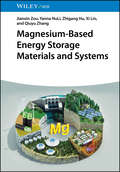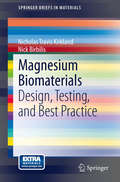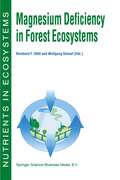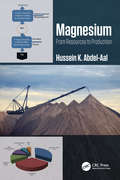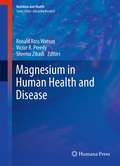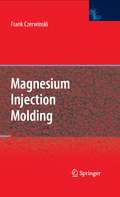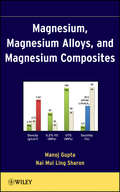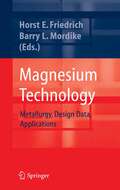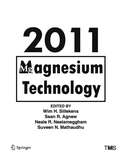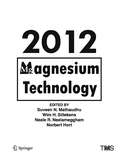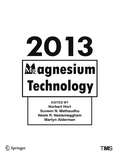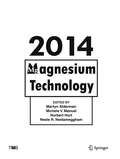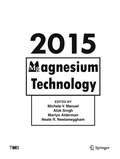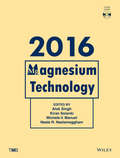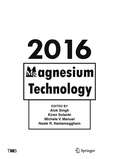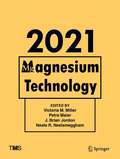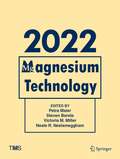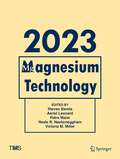- Table View
- List View
Magnesium-Based Energy Storage Materials and Systems
by Jianxin Zou Yanna NuLi Zhigang Hu Xi Lin Qiuyu ZhangMagnesium-Based Energy Storage Materials and Systems Understand the energy storage technologies of the future with this groundbreaking guide Magnesium-based materials have revolutionary potential within the field of clean and renewable energy. Their suitability to act as battery and hydrogen storage materials has placed them at the forefront of the world’s most significant research and technological initiatives. It has never been more essential that professionals working in energy storage and energy systems understand these materials and their extraordinary potential applications. Magnesium-Based Energy Storage Materials and Systems provides a thorough introduction to advanced Magnesium (Mg)-based materials, including both Mg-based hydrogen storage and Mg-based batteries. Offering both foundational knowledge and practical applications, including step-by-step device design processes, it also highlights interactions between Mg-based and other materials. The result is an indispensable guide to a groundbreaking set of renewable energy resources. Magnesium-Based Energy Storage Materials and Systems readers will also find: In-depth analysis of the effects of employing catalysts, nano-structuring Magnesium-based materials, and many more subjectsDetailed discussion of electrolyte, cathode, and anode materials for Magnesium batteriesSnapshots of in-progress areas of research and development Magnesium-Based Energy Storage Materials and Systems is ideal for materials scientists, inorganic chemists, solid state chemists, electrochemists, and chemical engineers.
Magnesium-Based Energy Storage Materials and Systems
by Jianxin Zou Yanna NuLi Zhigang Hu Xi Lin Qiuyu ZhangUnderstand the energy storage technologies of the future with this groundbreaking guide Magnesium-based materials have revolutionary potential within the field of clean and renewable energy. Their suitability to act as battery and hydrogen storage materials has placed them at the forefront of the world#s most significant research and technological initiatives. It has never been more essential that professionals working in energy storage and energy systems understand these materials and their extraordinary potential applications. Magnesium-Based Energy Storage Materials and Systems provides a thorough introduction to advanced Magnesium (Mg)-based materials, including both Mg-based hydrogen storage and Mg-based batteries. Offering both foundational knowledge and practical applications, including step-by-step device design processes, it also highlights interactions between Mg-based and other materials. The result is an indispensable guide to a groundbreaking set of renewable energy resources. Magnesium-Based Energy Storage Materials and Systems readers will also find: In-depth analysis of the effects of employing catalysts, nano-structuring Magnesium-based materials, and many more subjects Detailed discussion of electrolyte, cathode, and anode materials for Magnesium batteries Snapshots of in-progress areas of research and development Magnesium-Based Energy Storage Materials and Systems is ideal for materials scientists, inorganic chemists, solid state chemists, electrochemists, and chemical engineers.
Magnesium Biomaterials: Design, Testing, and Best Practice (SpringerBriefs in Materials)
by Nicholas Travis Kirkland Nick BirbilisMagnesium Biomaterials provides a succinct up-to-date overview of Magnesium biomaterial development, critically examines the types of in vitro experiments that may be performed, and investigates the numerous variables that affect Magnesium biodegradation when undertaking these experiments. This work also discusses the direction in which current Magnesium biomaterial development is heading and the necessary steps for future development of this field. Information is drawn from numerous multi-disciplinary sources to provide a coherent and critical overview. Magnesium Biomaterials is ideal for researchers in the area of bio-Mg, companies interested in exploring their own alloys, and for researchers working with other biodegradable materials who are seeking a cross-platform understanding of material performance.
Magnesium Deficiency in Forest Ecosystems (Nutrients in Ecosystems #1)
by Reinhard F. Hüttl Wolfgang W. SchaafR. F. HUTTL AND W. SCHAAF Brandenburg Technical University Cottbus, Chair of Soil Protection and Recultivation, P.O. Box 10 13 44, 03013 Cottbus, Germany The health status of forest trees and stands is determined by numerous site factors such as chemical, physical, and biological soil factors, water supply, climate, weather conditions, management history as well as atmospheric deposition impacts. In this context, the nutrient supply is an important evaluation parameter. Forest trees well supplied with nutrients are more resistant to stresses that affect the forest ecosystem than other trees. This is true for both biotic and abiotic influences. Therefore the investigation of the so-called 'new type forest damage' was aimed at the exact determination of the health status of damaged trees. When considering the complete forest ecosystem, health (=vitality) means the sustainable ability to withstand negative environmental influences and still remain stable and productive. From this viewpoint, an optimal nutritional status is a prerequisite for an optimal health status. The term 'new type forest damage' comprises a number of damage symptoms which have been observed in various tree species on very different sites since the mid-1970s, particularly in Europe and North America. However, they occurred much more intensively in the 1980s. Generally, this forest damage was thought to be related to negative impacts of air pollutants.
Magnesium: From Resources to Production
by Hussein K. Abdel-AalMagnesium is one of the most abundant minerals in seawater. Extracting magnesium from seawater could reduce cost of this mineral, resulting in positive implications for industries that use it. This book addresses mineral process engineering with emphasis on magnesium and provides practicing engineers and students with comprehensive knowledge on magnesium and how it is extracted from seawater and magnesium ores. It takes a chemical engineering approach as separation of magnesium from seawater involves the application of the powerful science of chemistry and transport phenomena principles. This monograph discusses magnesium resources and occurrence, includes an exploration study on deriving magnesium and mineral salts from seawater, and features coverage of magnesium chloride. It also covers commercial methods for magnesium production as an end product, current and prospective applications in the energy domain, and offers an account of the use of magnesium to store hydrogen in the form of magnesium hydride.
Magnesium in Human Health and Disease (Nutrition and Health)
by Ronald Ross Watson, Victor R. Preedy and Sherma ZibadiMagnesium is an essential mineral which is required for growth and survival of humans. Since magnesium is a mineral and not synthesizable it must be obtained through dietary foods and/or supplements. Magnesium in Human Health and Disease reviews the benefits of magnesium supplementation to reach recommended intakes as well as provides new research that suggests how reaching levels above the recommended intakes can promote health and treat various diseases. Magnesium deficiency can cause low serum potassium and calcium levels, retention of sodium, and low circulating levels of regulatory hormones. These changes in nutrients cause neurological and muscular symptoms such as tremor and muscle spasms. Further magnesium deficiency causes loss of appetite, nausea, vomiting, personality changes and death from heart failure. Causes of magnesium deficiency include alcohol abuse, poorly controlled diabetes, excessive or chronic vomiting and/or diarrhea. Thus the effects of inadequate and deficient intakes or levels of magnesium is critical to health and are reviewed by the expert clinicians in this book. Magnesium in Human Health and Disease provides the most current research to support the potential benefits or lack thereof for normal and high supplementation with magnesium. Animal model research and early human trials are reviewed to document other disease states such as hypertension, cholesterol level, type 2 diabetes and cardiovascular disease that would benefit from increased magnesium.
Magnesium Injection Molding
by Frank CzerwinskiThe objective of this book, being the first one on magnesium injection molding, is to treat both the scientific background and the technological aspects as they are understood at present. All aspects of material development, manufacturing and engineering are covered. The book provides a single source of information covering the interdisciplinary field of net shape forming of magnesium alloys. It reflects a unique blend of science and industrial practice.
Magnesium, Magnesium Alloys, and Magnesium Composites
by Manoj Gupta Sharon Nai Mui LingA look at the current and future uses of magnesium-based products and their role in the world's environmental and technological revolution The lightest of all structural metals, having one-fourth the density of steel and two-thirds that of aluminum, magnesium has already been adopted as an alternative construction material in applications as far ranging as automotive and sports equipment, electronics, and space technology. In a world concerned with minimizing the environmental impact of products, the choice of light-weight, energy-saving, and high-performance materials, like magnesium, would seem a small, significant step towards improving life on this planet. Magnesium, Magnesium Alloys, and Magnesium Composites introduces the science and current applications of this important metal, shedding light on the magnesium-based composites developed over the last fifteen years. Chapters include in-depth discussion of: The characteristics of pure magnesium—including atomic properties and crystal structure as well as physical, electrical, and mechanical properties Magnesium alloys—and the effects of the alloying elements, such as aluminum, lithium, copper, nickel, and silicon The properties of magnesium-based composites—and the effects of different types (metallic, ceramic, interconnected, and intermetallic) of reinforcements of varying length (from micron scale to nanometric length) Corrosion aspects of magnesium-based materials Magnesium-based products in medicine, sports equipment, and the automotive, aerospace, and electronics industries Bringing together, for the first time, the science, properties, and technologies relating to the current and future uses of magnesium, this important reference also offers readers a glimpse of a not-too-distant world in which environmental safety and sound engineering are a reality.
Magnesium, Magnesium Alloys, and Magnesium Composites: Processing, Mechanical And Corrosion Characteristics (Springerbriefs In Materials Ser.)
by Manoj Gupta Sharon Nai Mui LingA look at the current and future uses of magnesium-based products and their role in the world's environmental and technological revolution The lightest of all structural metals, having one-fourth the density of steel and two-thirds that of aluminum, magnesium has already been adopted as an alternative construction material in applications as far ranging as automotive and sports equipment, electronics, and space technology. In a world concerned with minimizing the environmental impact of products, the choice of light-weight, energy-saving, and high-performance materials, like magnesium, would seem a small, significant step towards improving life on this planet. Magnesium, Magnesium Alloys, and Magnesium Composites introduces the science and current applications of this important metal, shedding light on the magnesium-based composites developed over the last fifteen years. Chapters include in-depth discussion of: The characteristics of pure magnesium—including atomic properties and crystal structure as well as physical, electrical, and mechanical properties Magnesium alloys—and the effects of the alloying elements, such as aluminum, lithium, copper, nickel, and silicon The properties of magnesium-based composites—and the effects of different types (metallic, ceramic, interconnected, and intermetallic) of reinforcements of varying length (from micron scale to nanometric length) Corrosion aspects of magnesium-based materials Magnesium-based products in medicine, sports equipment, and the automotive, aerospace, and electronics industries Bringing together, for the first time, the science, properties, and technologies relating to the current and future uses of magnesium, this important reference also offers readers a glimpse of a not-too-distant world in which environmental safety and sound engineering are a reality.
Magnesium Technology: Metallurgy, Design Data, Applications
by Horst E. Friedrich Barry Leslie MordikeMagnesium, with a density of 1.74 g/cm², is the lightest structural metal and magnesium are increasingly chosen for weight-critical applications such as in land-based transport systems. "Magnesium Technology" substantially updates and complements existing reference sources on this key material. It assembles international contributions from seven countries covering a wide range of research programs into new alloys with the requisite property profiles, i.e., the current state of both research and technological applications of magnesium. In particular, the international team of authors covers key topics, such as: casting and wrought alloys; fabrication methods; corrosion and protection; engineering requirements and strategies, with examples from the automobile, aerospace, and consumer-goods industries, and recycling. This authoritative reference and overview addresses materials researchers as well as design engineers.
Magnesium Technology 2011 (The Minerals, Metals & Materials Series)
The Magnesium Technology Symposium, which takes place every year at the TMS Annual Meeting & Exhibition, is one of the largest yearly gatherings of magnesium specialists in the world. Papers are presented in all aspects of the field, ranging from primary production to applications to recycling. Moreover, papers explore everything from basic research findings to industrialization. Magnesium Technology 2011 covers a broad spectrum of current topics, including alloys and their properties; cast products and processing; wrought products and processing; forming, joining, and machining; corrosion and surface finishing; ecology; and structural applications. In addition, you'll find coverage of new and emerging applications in such areas as biomedicine and hydrogen storage.
Magnesium Technology 2012 (The Minerals, Metals & Materials Series)
The Magnesium Technology Symposium, which takes place every year at the TMS Annual Meeting & Exhibition, is one of the largest yearly gatherings of magnesium specialists in the world. Papers are presented in all aspects of the field, ranging from primary production to applications to recycling. Moreover, papers explore everything from basic research findings to industrialization. Magnesium Technology 2011 covers a broad spectrum of current topics, including alloys and their properties; cast products and processing; wrought products and processing; forming, joining, and machining; corrosion and surface finishing; ecology; and structural applications. In addition, you'll find coverage of new and emerging applications in such areas as biomedicine and hydrogen storage.
Magnesium Technology 2013 (The Minerals, Metals & Materials Series)
The Magnesium Technology Symposium, the event on which this volume is based, is one of the largest yearly gatherings of magnesium experts in the world. Papers reflect all aspects of the field including primary production to applications, recycling, basic research findings, and industrialization. Readers will find broad coverage of current topics, including alloys and their properties, cast products and processing, wrought products and processing, corrosion and surface finishing, ecology, and more. New and emerging applications in such areas as hydrogen storage are also examined.
Magnesium Technology 2014 (The Minerals, Metals & Materials Series)
The Magnesium Technology Symposium, the event on which this collection is based, is one of the largest yearly gatherings of magnesium specialists in the world. Papers in this collection represent all aspects of the field, ranging from primary production to applications to recycling. Moreover, papers explore everything from basic research findings to industrialization. This volume covers a broad spectrum of current topics, including alloys and their properties; cast products and processing; wrought products and processing; forming, joining, and machining; corrosion and surface finishing; ecology; and structural applications. In addition, there is coverage of new and emerging applications in such areas as hydrogen storage.
Magnesium Technology 2015 (The Minerals, Metals & Materials Series)
The Magnesium Technology Symposium, the event on which this collection is based, is one of the largest yearly gatherings of magnesium specialists in the world. Papers represent all aspects of the field, ranging from primary production to applications to recycling. Moreover, papers explore everything from basic research findings to industrialization. Magnesium Technology 2015 covers a broad spectrum of current topics, including alloys and their properties; cast products and processing; wrought products and processing; forming, joining, and machining; corrosion and surface finishing; ecology; and structural applications. In addition, there is coverage of new and emerging applications.
Magnesium Technology 2016 (The Minerals, Metals & Materials Series)
by Alok SinghThe Magnesium Technology Symposium, the event on which this collection is based, is one of the largest yearly gatherings of magnesium specialists in the world. Papers represent all aspects of the field, ranging from primary production to applications to recycling. Moreover, papers explore everything from basic research findings to industrialization. Magnesium Technology 2016 covers a broad spectrum of current topics, including alloys and their properties; cast products and processing; wrought products and processing; forming, joining, and machining; corrosion and surface finishing; ecology; and structural applications. In addition, there is coverage of new and emerging applications. The collection includes more than 50 papers.
Magnesium Technology 2016 (The Minerals, Metals & Materials Series)
The Magnesium Technology Symposium, the event on which this collection is based, is one of the largest yearly gatherings of magnesium specialists in the world. Papers represent all aspects of the field, ranging from primary production to applications to recycling. Moreover, papers explore everything from basic research findings to industrialization. Magnesium Technology 2016 covers a broad spectrum of current topics, including alloys and their properties; cast products and processing; wrought products and processing; forming, joining, and machining; corrosion and surface finishing; ecology; and structural applications. In addition, there is coverage of new and emerging applications.
Magnesium Technology 2017 (The Minerals, Metals & Materials Series)
by Kiran N. Solanki Dmytro Orlov Alok Singh Neale R. NeelamegghamThe Magnesium Technology Symposium, the event on which this collection is based, is one of the largest yearly gatherings of magnesium specialists in the world. Papers represent all aspects of the field, ranging from primary production to applications to recycling. Moreover, papers explore everything from basic research findings to industrialization. Magnesium Technology 2017 covers a broad spectrum of current topics, including alloys and their properties; cast products and processing; wrought products and processing; forming, joining, and machining; corrosion and surface finishing; ecology; and structural applications. In addition, there is coverage of new and emerging applications.
Magnesium Technology 2018 (The Minerals, Metals & Materials Series)
by Dmytro Orlov Vineet Joshi Kiran N. Solanki Neale R. NeelamegghamThe Magnesium Technology Symposium, the event on which this collection is based, is one of the largest yearly gatherings of magnesium specialists in the world. Papers represent all aspects of the field, ranging from primary production to applications to recycling. Moreover, papers explore everything from basic research findings to industrialization. Magnesium Technology 2017 covers a broad spectrum of current topics, including alloys and their properties; cast products and processing; wrought products and processing; forming, joining, and machining; corrosion and surface finishing; ecology; and structural applications. In addition, there is coverage of new and emerging applications.
Magnesium Technology 2019 (The Minerals, Metals & Materials Series)
by Vineet V. Joshi J. Brian Jordon Dmytro Orlov Neale R. NeelamegghamThe Magnesium Technology Symposium, the event on which this collection is based, is one of the largest yearly gatherings of magnesium specialists in the world. Papers represent all aspects of the field, ranging from primary production to applications to recycling. Moreover, papers explore everything from basic research findings to industrialization. Magnesium Technology 2019 covers a broad spectrum of current topics, including alloys and their properties; cast products and processing; wrought products and processing; forming, joining, and machining; corrosion and surface finishing; and structural applications. In addition, there is coverage of new and emerging applications.
Magnesium Technology 2020 (The Minerals, Metals & Materials Series)
by Victoria Miller Neale R. Neelameggham Vineet V. Joshi J. Brian JordonThe Magnesium Technology Symposium, the event on which this collection is based, is one of the largest yearly gatherings of magnesium specialists in the world. Papers represent all aspects of the field, ranging from primary production to applications to recycling. Moreover, papers explore everything from basic research findings to industrialization. Magnesium Technology 2020 covers a broad spectrum of current topics, including alloys and their properties; cast products and processing; wrought products and processing; forming, joining, and machining; corrosion and surface finishing; and structural applications. In addition, there is coverage of new and emerging applications.
Magnesium Technology 2021 (The Minerals, Metals & Materials Series)
by Victoria M. Miller Petra Maier J. Brian Jordon Neale R. NeelamegghamThe Magnesium Technology Symposium, the event on which this collection is based, is one of the largest yearly gatherings of magnesium specialists in the world. Papers represent all aspects of the field, ranging from primary production to applications to recycling. Moreover, papers explore everything from basic research findings to industrialization. Magnesium Technology 2021 is a definitive reference that covers a broad spectrum of current topics, including novel extraction techniques; primary production; alloys and their production; thermodynamics and kinetics; cast products and processing; wrought products and processing; forming, joining, and machining; corrosion and surface finishing; structural applications; degradation and biomedical applications; and several others.
Magnesium Technology 2022 (The Minerals, Metals & Materials Series)
by Neale R. Neelameggham Victoria M. Miller Petra Maier Steven BarelaThe Magnesium Technology Symposium at the TMS Annual Meeting & Exhibition is one of the largest yearly gatherings of magnesium specialists in the world. Papers represent all aspects of the field, ranging from primary production to applications and recycling. Moreover, papers explore everything from basic research findings to industrialization. Magnesium Technology 2022 is a definitive reference that covers a broad spectrum of current topics, including novel extraction techniques; primary production; alloys and their production; integrated computational materials engineering; thermodynamics and kinetics; plasticity mechanisms; cast products and processing; wrought products and processing; forming, joining, and machining; corrosion and surface finishing; fatigue and fracture; dynamic response; structural applications; degradation and biomedical applications; emerging applications; additive manufacturing of powders; and recycling, ecological issues, and life cycle analysis.
Magnesium Technology 2023 (The Minerals, Metals & Materials Series)
by Steven Barela Aeriel Leonard Petra Maier Neale R. Neelameggham Victoria M. MillerThe Magnesium Technology Symposium at the TMS Annual Meeting & Exhibition is one of the largest yearly gatherings of magnesium specialists in the world. Papers represent all aspects of the field, ranging from primary production to applications and recycling. Moreover, papers explore everything from basic research findings to industrialization. Magnesium Technology 2023 is a definitive reference that covers a broad spectrum of current topics, including novel extraction techniques; primary production; alloys and their production; integrated computational materials engineering; thermodynamics and kinetics; plasticity mechanisms; cast products and processing; wrought products and processing; forming, joining, and machining; corrosion and surface finishing; fatigue and fracture; dynamic response; structural applications; degradation and biomedical applications; emerging applications; additive manufacturing of powders; and recycling, ecological issues, and life cycle analysis.
Magnesium und seine Legierungen (Klassiker der Technik)
by Adolf BeckAus dem Vorwort zur 2. Auflage: In vielen Bereichen ist ein alter und zugleich neuer Werkstoff "Magnesium" als leichtes- ter metallischer Konstruktionswerkstoff sehr aktuell gewor- den. Magnesium ist eine Herausforderung unserer Zeit und ge- hört bei weitem nicht zum "alten Eisen". Masseeinsparungen bei guter mechanischer Festigkeit, Recyclefähigkeit sind in vielen Bereichen aktueller denn je. Concise text: Magnesium ist eine Herausforderung unserer Zeit und gehört bei weitem nicht zum "alten Eisen". Masseeinsparungen bei guter mechanischer Festigkeit, Recyclefähigkeit sind in vielen Bereichen aktueller denn je.
